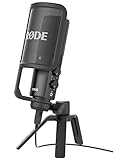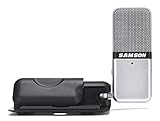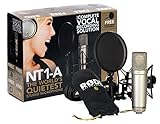Podcasting gives laymen people the ability to communicate with potentially millions of people on the internet at once. You do not need a fancy commercial studio or sound recording equipment to make this happen. All you need is an average consumer-grade computer, a high-speed internet connection, and a decent microphone. If you have always wished that you could speak on the radio about topics that interest you and grow a fan base around your broadcasts, then podcasting is for you. Rather than trying to get a job at a radio station, you can become an entrepreneur and just create your own internet radio station instead.
Contents
How to Pick the Best Podcast Microphone
Microphones come in various shapes, sizes, and levels of quality. The microphone that is right for someone else might not be right for you, and vice versa. Below are the factors you should consider when choosing a microphone to conduct your own podcasts.
Your Budget – Most people will check the price of the microphone before anything else. Good microphones used to cost hundreds of dollars but now you can get some high-quality ones for less than $100. Of course, the more money you spend on a microphone, the better sound quality it is going to be. A lot of people starting out with their podcasts may choose the most affordable microphone at first. If they are able to grow a large following from the podcast, this may give them an incentive to spend more money on a better microphone. That way, it can be like a reward to their fans by giving them better sound quality.
Connectivity – Microphones may have a 3.5 mm, USB, or XLR connection type. The 3.5 mm is the classic connection port which has been on computers and audio equipment for decades. However, it seems to slowly be getting phased out. You might want to stick with either XLR or USB instead. They continue to be the most popular in the current market.
What type of device do you use? – The traditional way to conduct a podcast is on a laptop or desktop computer. This seems to be changing because more people are now connected to the internet through their smart devices. They love the ability to have mobility in their podcasts, which is what a smartphone or tablet allows them to do. All they need is a Wi-Fi connection and a good microphone connected to their smart device. Then they can podcast from anywhere. If you’re an Apple fan, then check out the best mics for iOS.
Additional Accessories – When you purchase a microphone, you will need to purchase some important accessories for it too. These accessories will maximize the performance of the microphone while making it more comfortable for you to use. These accessories would include a shock mount, microphone stand, or pop filter/shield. Sometimes you may find mic package deals where these accessories and microphones are sold together because of how well they work together.
For anybody looking to start their own podcast we highly recommend the following article to get you up and running: How To Start A Successful Podcast
The Best Podcast Microphones
After carefully reviewing all the latest podcast microphones on the market today, we created the following list of the 10 best podcast microphones. These microphones include commercial-grade models as well as economically friendly models for those on a budget. Chances are that you will find a microphone on this list that meets your specifications.
Blue Yeti Microphone
The Blue Yeti features a headphone jack and a USB port. If you need to adjust the microphone as you are using it, there is a simple tilting mechanism which easily gives you this ability. The sound quality itself is considered to be “semi-professional.” The price for the microphone on Amazon is currently $124.81. Some people may find this affordable while others will want something much less. Just remember this is a USB microphone which can plug right into your computer. If you want to record podcasts, this microphone is simple and effective to use for this purpose.
Rode Podcaster
The Rode Podcaster is a little bit better than the Yeti but also costs about one hundred dollars more too. Overall, it is worth trying out for podcasting.
CAD U37
Another great feature on the CAD U37 is the switch that reduces the bass, which is suitable for more experienced users. You won’t need to worry about purchasing a separate mount or stand accessory either because the CAD U37 comes with a small stand to use on your desktop.
As soon as you take the CAD U37 out of its packaging, you can use the USB cord to immediately connect the microphone to your computer, whether it’s a Mac or PC. Therefore, anyone looking for a truly affordable microphone for conducting their podcasts will want to try the CAD U37. It will not disappoint.
Audio-Technica AT2020USB
For podcasting, the Audio-Technica AT2020USB seems to be one of the best microphones out there. It is fairly priced at under $150, so it is a worthy investment.
Samson Meteor
The Samson Meteor comes with a small desk stand which is built into the microphone. Anyone in an office or sitting at a computer desk will find this extremely beneficial. Behind the Samson Meteor, there is a USB port and headphone out for connecting your USB cord and headphone wires; respectively. Other features in the back include a mute switch and a control for the headphone volume.
Anyone looking for a reasonably priced podcast microphone will be happy with the Samson Meteor.
Rode NT-USB
There is no doubt that this is a great microphone for podcasting. If you don’t mind spending $169.99, then you should go for it.
Samson Go Mic
As for the sound quality, the Go Mic delivers 44.1 kHz / 16-bit audio. This is the same rate as other microphones which are double the price. It will be slightly better than the sound quality of CD audio.
Anyone who likes to conduct their podcasts away from their home or office, the Samson Go Mic is the perfect microphone to use while on the road.
Blue Spark
You will be surprised to see that Blue Spark is packaged inside a wooden box. Other accessories included with it are a pop filter and custom shock mount. The only accessory you need to purchase separately is the stand.
RODE NT1-A
If you do not mind spending a little over $200 on a high-quality microphone, then you will love the Rode NT1-A.
Focusrite Scarlett Studio Pack
When the Focusrite Scarlett Studio Pack gets delivered to your doorstep, you will be able to use it right away. You do not have to go out and purchase all these individual accessories because they come included in the bundle. This will save you time, energy, and money!

























Leave a Reply